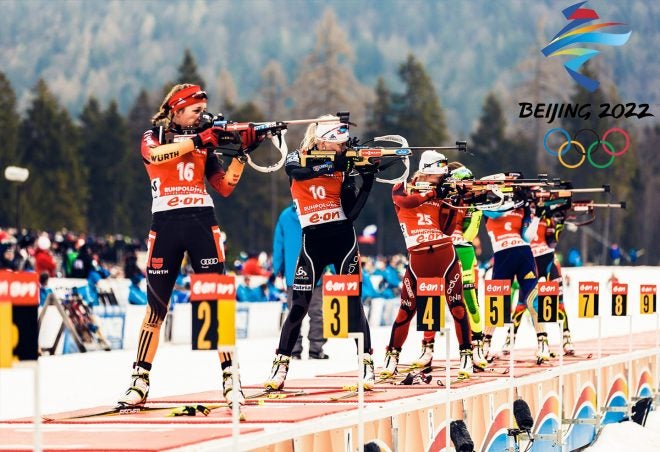The Olympic Biathlon has always intrigued me. A sport with roots in Scandinavian military history, the Biathlon is a test of not only athletic prowess but marksmanship as well. Today in the Rimfire Report we’ll briefly delve into the history and modern interpretation of the Olympic Biathlon as well as the Rimfire Rifles that are used today in the sport.
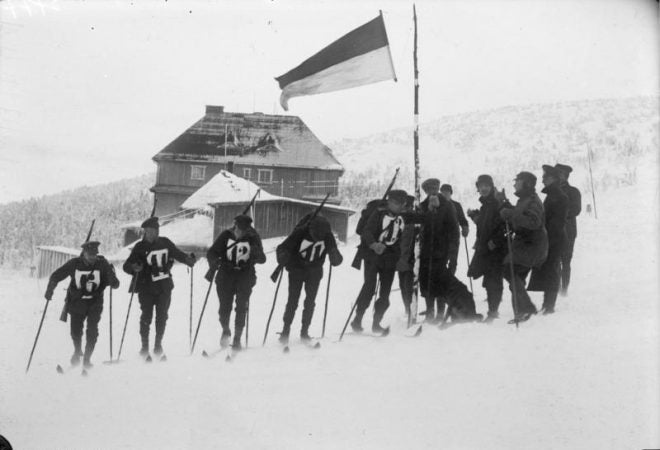
Olympic Biathlon – The progenitor of the modern Biathlon the “Military Patrol.”
Olympic Biathlon – Military Roots
The Biathlon can trace its roots back to Scandinavian Military Skiing Tradition. An alternative to traditional military training, the competitors were divided into 4 distinct disciplines. The first involved shooting at targets while skiing at top speed. Another was skiing downhill in a race among trees. The final two were a downhill race on big hills without falling, and a long race on flat ground while carrying a rifle and military pack.
The Biathlon we know today takes its inspiration from the original military combined exercise of skiing and shooting. In a bid to promote civilian marksmanship, the Norwegen government set up a competition consisting of a 12-kilometer race with large-caliber rifle shooting at various ranges. This variant of the competition was called “military patrol.”
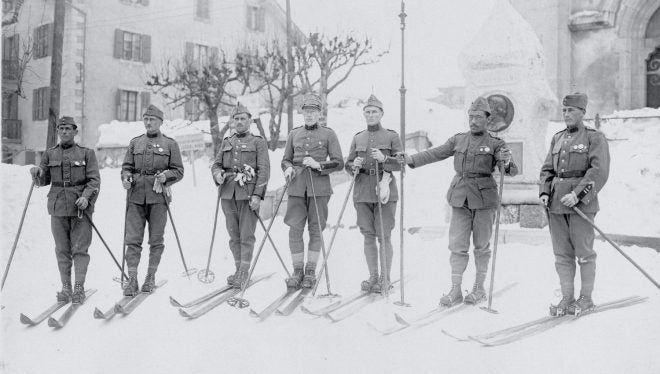
Olympic Biathlon – The first Olympic demonstration of the Military Patrol took place at the 1924 Olympics in Chamonix, France
The military patrol would go on to be contested and demonstrated in the Winter Olympic Games in 1924, 1936 and 1948 but would not gain widespread recognition until 1950 because of the small number of competing countries. Additionally, the competition and demonstration were only open to members of the country’s armed forces until 1960, further contributing to the small amount of competitors.
The Biathlon made its first official Olympic Games debut in 1960 at Squaw Valley, California. The competition involved a 20-kilometer cross-country ski race with four shooting stations at ranges from 100 to 250 m (330 to 820 ft). Klas Lestander from Sweden became the first Olympic Biathlon champion. The modern Olympic Biathlon is governed by the IBU – International Biathlon Union, which sets rules and regulations for the competition.
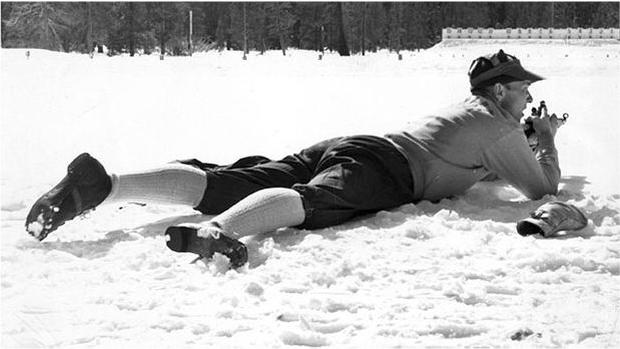
Olympic Biathlon – Klas Lestander would be the first Olympic Champion of the Biathlon in 1960
Rules and Equipment
The Biathlon may seem simple but the rules can get quite complex and competitors can find themselves being heavily penalized for small mistakes. Generally, a Biathlon race will consist of a cross-country skiing trail system with either two or four shooting stations. Half the stations will be shot from the prone position while the other half will be shot from the standing position.
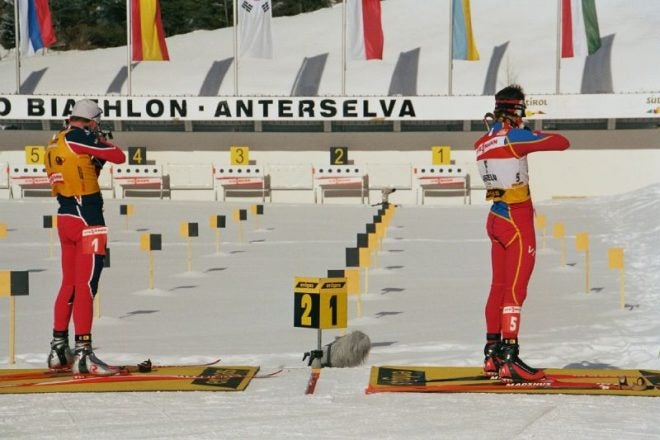
Olympic Biathlon The 2006 Winter Olympics – Two Biathletes compete in the Standing portion of the Biathlon.
Target Distance and Size
At each shooting station, the competitor must engage and hit five targets placed at 50 meters. Target diameters are 45mm for prone shooting and 115 mm for the standing position. This translates to angular target sizes of about 1 and 2.5 MRAD respectively and about 1.7 inches and 4.5 inches in freedom units. Nothing to scoff at for a 50-yard engagement distance. On all modern biathlon ranges, the targets flip from black to white when hit, giving the biathlete, as well as the spectators, instant visual feedback for each shot fired.
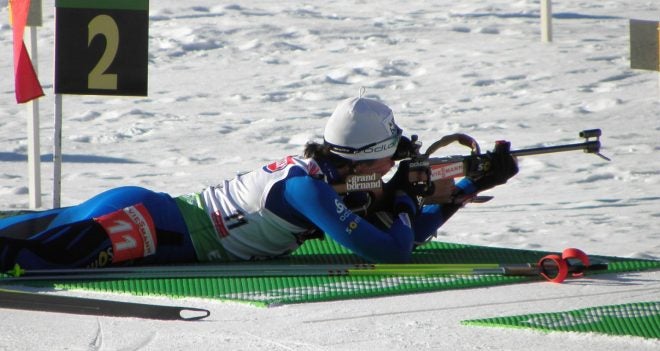
Olympic Biathlon – Shooting from the Prone Position will consist of half the total shooting stages mixed in with cross-country skiing.
Penalties
Each missed target (not hit at all) incurs a penalty of added skiing distance. Each missed target the competitor must ski around a 150-meter “penalty loop” which typically takes 20-30 seconds for the most elite athletes. Use of extra cartridges placed at the shooting position can aid the shooter in making up missed shots, however, only three such extra cartridges are placed at the shooting range and the competitor will still incur the 150-meter penalty loop for each target left standing.
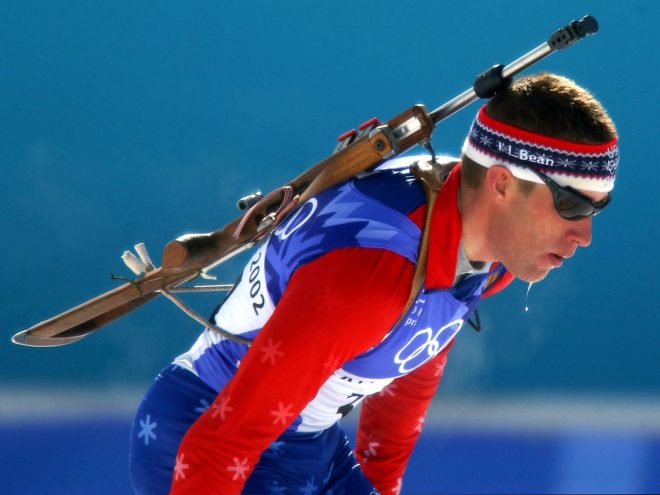
Olympic Biathlon – Jeremy Teela Competing in the 2002 Winter Olympics. Penalties inured can quickly wear out a competitor.
Skiing
All cross-country skiing methods are permitted during the competition. This allows for the very popular “skate skiing” style which is by far the fastest method and doesn’t involve the use of poles or extra equipment. Ski length is regulated to a minimum of the height of the minus four centimeters. The rifle must be carried by the skier during the race at all times.
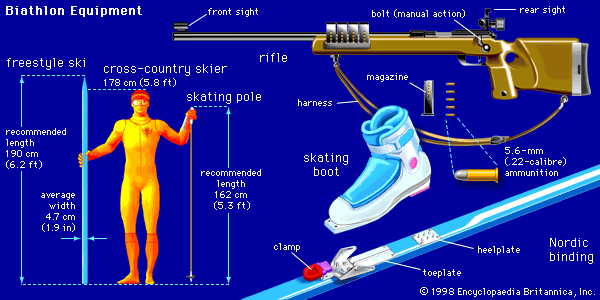
Olympic Biathlon – A diagram showing the various equipment regulations required by the IBU. Source: 1998 Encyclopedia Britannica
Rifle and Ammunition Details
The first rifles used in the Biathlon were most often high-power centerfire rifles using 30-06 Springfield or 7.62x51mm NATO cartridges. By 1978, 22 Long Rifle rimfire was standardized as the official caliber of the Biathlon.
Rifle Details
As mentioned above, the athlete must carry their small-bore rifle at all times. The minimum weight for the rifle is 3.5 kg or roughly 7.71 pounds excluding the magazine and ammunition. The rifles are all limited to .22LR ammunition and must be bolt action or straight-pull bolt action (also called Fortner Action). Specialist biathlon rifles are usually equipped with straight-pull actions, integrated magazine carriers, and ergonomic stock designs suitable for both prone and standing shooting positions.
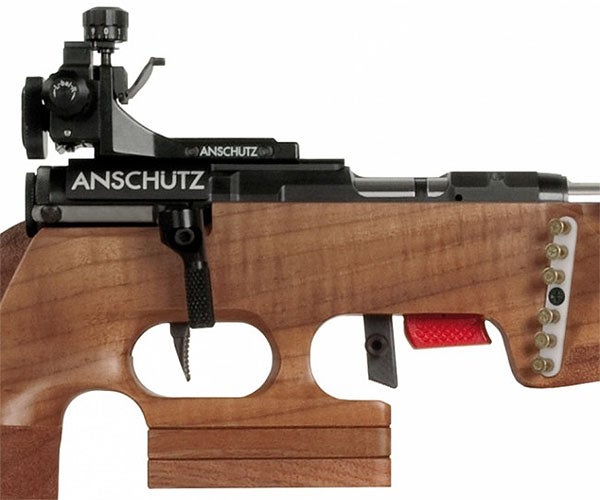
Olympic Biathlon – Anschutz is by far the most common rifle manufacturer for the Biathlon. Note the six spare rounds integrated into the stock of the rifle.
One unique feature you’ll find on a biathlon rifle is a pistol grip with an integrated thumb rest which is there to isolate the movement of the trigger finger from that of the thumb which are known to have a tendency to move together as a form of sympathetic reflex.
Manual safeties are not required and the governing body of the Biathlon competition, the IBU requires that the trigger pull weight to be no less than 1.1lbs. There are no optics allowed in IBU competitions, only non-magnified diopter rear and globe front sights are permitted. An eyecup (blinder) is often used instead of eye protection, but this is an optional feature and not all shooters will choose to use them. Hearing protection is not required either, most loads fired from these rifles are subsonic anyway.
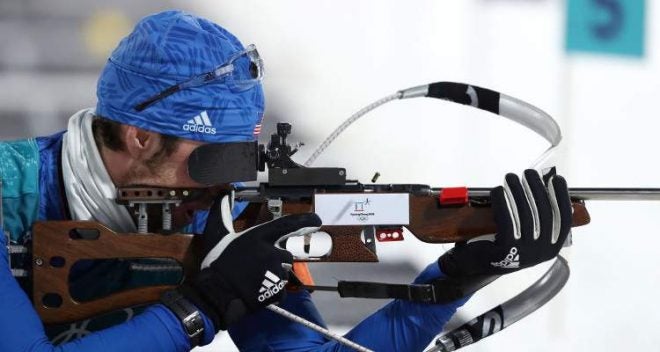
Olympic Biathlon – An example of a shooter using a blinder to aid in aiming the rifle
The current standard for biathlon rifles is the Anschütz 1827 Fortner, which is reported to be used by an estimated 97% of biathlon competitors worldwide.
Ammunition
With .22LR being the standard caliber for IBU sanctioned competitions, you can expect some high-end ammunition to be used. With .22LR being notoriously unreliable compared to centerfire cartridges, manufacturers take great care to ensure their specialized ammo can withstand not only the tough conditions of being jostled around during skiing but hold extremely tight group sized in freezing temperatures commonly found during Winter Olympic conditions.
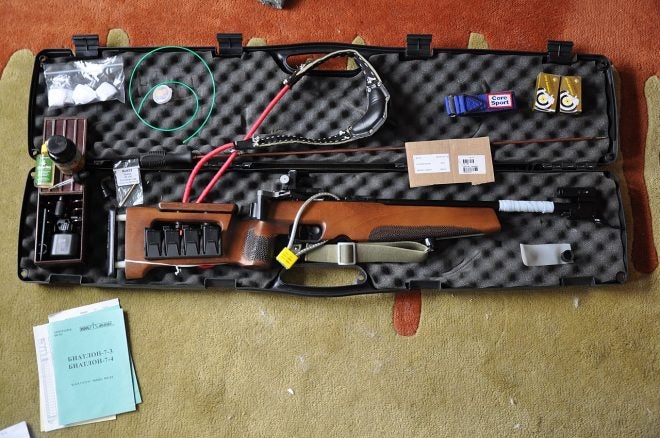
Olympic Biathlon – A typical Biathlon case containing rifle, integrated spare magazines and competition-grade ammunition.
The current ruling by the IBU was established in 1978 when .22LR was made the required caliber for the Biathlon. The Muzzle velocity of the competitor’s ammunition must not exceed 360 meters per second or about 1,181 feet per second. This adds an additional layer of complexity to each shot as most ammunition produced for IBU Biathlons is subsonic, creating greater bullet drop even at the short 50-meter distance. At 150ft even some faster moving bullets can drop as much as 7 inches.
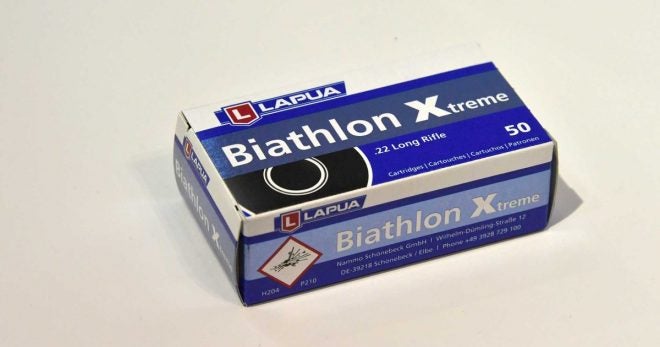
Olympic Biathlon – Lapua Biathlon Xtreme is one such caliber designed to operate consistently in cold weather conditions often found during biathlon races.
Bullet weight is mostly restricted to 40 grains or as the IBU would put it “between 2.55 and 2.75 grams.” Maintenance is key for this competition because of the tendency of lead-fouling to build up in the receiver ruining an otherwise good run time. Common manufacturers for Biathlon ammunition are Lapua, Eley, and RWS. This ammunition, however, does not come cheap, with boxes of 500 rounds costing upwards of $200 USD ($0.40 CPR).
2022 Olympics
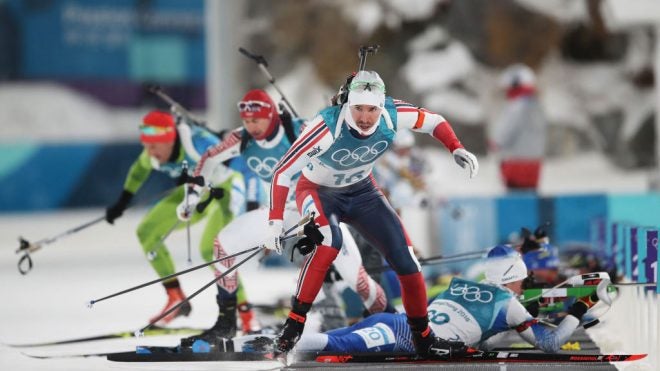
Olympic Biathlon – Competitors moving from one stage to the next after completing a course of fire.
With the 2022 Winter Olympics well on their way, competitors are beginning training now for one of the most fast-paced and fierce competitions during the winter Olympics. Hopefully, this brief overview and explanation of the Olympic Biathlon will elevate your enjoyment of the sport if you happen to catch it next time the Olympics Air for Beijing 2022. Until then, thanks for stopping by and reading The Rimfire Report.
We are committed to finding, researching, and recommending the best products. We earn commissions from purchases you make using the retail links in our product reviews. Learn more about how this works.
 Your Privacy Choices
Your Privacy Choices
